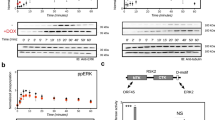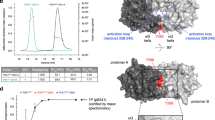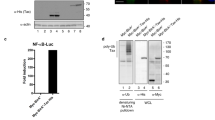Abstract
The N-terminal calponin homology (CH) domain of Vav guanine nucleotide exchange factor is thought to serve a regulatory role in the autoinhibition, however, its precise function is not entirely clear. We found that the adaptor molecule APS could bind the CH domain of Vav3, a member of the vav proto-oncogene family. The binding of Vav3 and APS was apparently stabilized by the tyrosine phosphorylation of Vav3 by Lck, and the association of APS with Vav3 in turn enhanced the Lck-mediated phosphorylation of Vav3. Focus formation assays demonstrated that APS could increase the transforming activity of proto-Vav3. Further analyses revealed that the Vav3 CH domain could bind the pleckstrin homology (PH) domain of APS and that this binding was indispensable to enhance the transforming activity of Vav3. We present here a novel stimulatory mechanism of Vav3 in which APS directly relieves the autoinhibitory CH domain and furthermore enhances its tyrosine phosphorylation by Lck.
This is a preview of subscription content, access via your institution
Access options
Subscribe to this journal
Receive 50 print issues and online access
$259.00 per year
only $5.18 per issue
Buy this article
- Purchase on Springer Link
- Instant access to full article PDF
Prices may be subject to local taxes which are calculated during checkout






Similar content being viewed by others
References
Abe K, Rossman KL, Liu B, Ritola KD, Chiang D, Campbell SL, Burridge K, Der CJ . 2000 J. Biol. Chem. 275: 10141–10149
Abe K, Whitehead IP, O'Bryan JP, Der CJ . 1999 J. Biol. Chem. 274: 30410–30418
Adams JM, Houston H, Allen J, Lints T, Harvey R . 1992 Oncogene 7: 611–618
Aghazadeh B, Lowry WE, Huang XY, Rosen MK . 2000 Cell 102: 625–633
Alberts AS, Treisman R . 1998 EMBO J. 17: 4075–4085
Bhattacharyya R, Wedegaertner PB . 2000 J. Biol. Chem. 275: 14992–14999
Bi F, Debreceni B, Zhu K, Salani B, Eva A, Zheng Y . 2001 Mol. Cell. Biol. 21: 1463–1474
Bustelo XR . 2000 Mol. Cell. Biol. 20: 1461–1477
Bustelo XR, Crespo P, Lopez-Barahona M, Gutkind JS, Barbacid M . 1997 Oncogene 15: 2511–2520
Castresana J, Saraste M . 1995 FEBS Lett. 374: 149–151
Cerione RA, Zheng Y . 1996 Curr. Opin. Cell Biol. 8: 216–222
Clark EA, Golub TR, Lander ES, Hynes RO . 2000 Nature 406: 532–535
Clark GJ, Cox AD, Graham SM, Der CJ . 1995 Methods Enzymol. 255: 395–412
Crespo P, Schuebel KE, Ostrom AA, Gutkind JS, Bustelo XR . 1997 Nature 385: 169–172
Das B, Shu X, Day GJ, Han J, Krishna ÌM, Falck JR, Broek D . 2000 J. Biol. Chem. 275: 15074–15081
De Sepulveda P, Ilangumaran S, Rottapel R . 2000 J. Biol. Chem. 275: 14005–14008
Deckert M, Tartare-Deckert S, Couture C, Mustelin T, Altman A . 1996 Immunity 5: 591–604
Doody GM, Bell SE, Vigorito E, Clayton E, McAdam S, Tooze R, Fernandez C, Lee IJ, Turner M . 2001 Nature Immunol. 2: 542–547
Gimona M, Winder SJ . 1998 Curr. Biol. 8: R674–R675
Habets GG, Scholtes EH, Zuydgeest D, van der Kammen RA, Stam JC, Berns A, Collard JG . 1994 Cell 77: 537–549
Hall A . 1998 Science 279: 509–514
Han J, Das B, Wei W, Van Aelst L, Mosteller RD, Khosravi-Far R, Westwick JK, Der CJ, Broek D . 1997 Mol. Cell. Biol. 17: 1346–1353
Han J, Luby-Phelps K, Das B, Shu X, Xia Y, Mosteller RD, Krishna ÌM, Falck JR, White MA, Broek D . 1998 Science 279: 558–560
Hart MJ, Jiang X, Kozasa T, Roscoe W, Singer WD, Gilman AG, Sternweis PC, Bollag G . 1998 Science 280: 2112–2114
Hobert O, Jallal B, Ullrich A . 1996 Mol. Cell. Biol. 16: 3066–3073
Horii Y, Beeler JF, Sakaguchi K, Tachibana M, Miki T . 1994 EMBO J. 13: 4776–4786
Inabe K, Ishiai M, Scharenberg AM, Freshney N, Downward J, Kurosaki T . 2002 J. Exp. Med. 195: 189–200
Iseki M, Takaki S, Takatsu K . 2000 Biochem. Biophys. Res. Commun. 272: 45–54
Katzav S, Cleveland JL, Heslop HE, Pulido D . 1991 Mol. Cell. Biol. 11: 1912–1920
Katzav S, Martin-Zanca D, Barbacid M . 1989 EMBO J. 8: 2283–2290
Katzav S, Sutherland M, Packham G, Yi T, Weiss A . 1994 J. Biol. Chem. 269: 32579–32585
Kawasaki Y, Senda T, Ishidate T, Koyama R, Morishita T, Iwayama Y, Higuchi O, Akiyama T . 2000 Science 289: 1194–1197
Miki T, Smith CL, Long JE, Eva A, Fleming TP . 1993 Nature 362: 462–465
Moores SL, Selfors LM, Fredericks J, Breit T, Fujikawa K, Alt FW, Brugge JS, Swat W . 2000 Mol. Cell. Biol. 20: 6364–6373
Movilla N, Bustelo XR . 1999 Mol. Cell. Biol. 19: 7870–7885
Osborne MA, Dalton S, Kochan JP . 1995 Biotechnology (NY) 13: 1474–1478
Ron D, Graziani G, Aaronson SA, Eva A . 1989 Oncogene 4: 1067–1072
Schuebel KE, Bustelo XR, Nielsen DA, Song BJ, Barbacid M, Goldman D, Lee IJ . 1996 Oncogene 13: 363–371
Schuebel KE, Movilla N, Rosa JL, Bustelo XR . 1998 EMBO J. 17: 6608–6621
Stradal T, Kranewitter W, Winder SJ, Gimona M . 1998 FEBS Lett. 431: 134–137
Takaki S, Sauer K, Iritani BM, Chien S, Ebihara Y, Tsuji K, Takatsu K, Perlmutter RM . 2000 Immunity 13: 599–609
Tedford K, Nitschke L, Girkontaite I, Charlesworth A, Chan G, Sakk V, Barbacid M, Fischer K-D . 2001 Nature Immunol. 2: 548–555
Van Aelst L, D'Souza-Schorey C . 1997 Genes Dev. 11: 2295–2322
Wakioka T, Sasaki A, Mitsui K, Yokouchi M, Inoue A, Komiya S, Yoshimura A . 1999 Leukemia 13: 760–767
Whitehead IP, Campbell S, Rossman KL, Der CJ . 1997 Biochim. Biophys. Acta 1332: F1–F23
Yokouchi M, Suzuki R, Masuhara M, Komiya S, Inoue A, Yoshimura A . 1997 Oncogene 15: 7–15
Yokouchi M, Wakioka T, Sakamoto H, Yasukawa H, Ohtsuka S, Sasaki A, Ohtsubo M, Valius M, Inoue A, Komiya S, Yoshimura A . 1999 Oncogene 18: 759–767
Zeng L, Sachdev P, Yan L, Chan JL, Trenkle T, McClelland M, Welsh J, Wang LH . 2000 Mol. Cell. Biol. 20: 9212–9224
Acknowledgements
We thank Drs Tohru Tezuka and Tadashi Yamamoto for their gift of expression plasmid encoding Lck, Dr Takaya Satoh for the expression plasmid of proto-Dbl. This work was supported by Grants-in-Aid for Special Project Research on Cancer-Bioscience 12215024 from the Ministry of Education, Culture, Sports, Science, and Technology in Japan and for the program ‘Research for the Future’ of Japan Society for Promotion of Science
Author information
Authors and Affiliations
Corresponding author
Rights and permissions
About this article
Cite this article
Yabana, N., Shibuya, M. Adaptor protein APS binds the NH2-terminal autoinhibitory domain of guanine nucleotide exchange factor Vav3 and augments its activity. Oncogene 21, 7720–7729 (2002). https://doi.org/10.1038/sj.onc.1205927
Received:
Revised:
Accepted:
Published:
Issue Date:
DOI: https://doi.org/10.1038/sj.onc.1205927
Keywords
This article is cited by
-
Altered DNA methylation indicates an oscillatory flow mediated epithelial-to-mesenchymal transition signature in ascending aorta of patients with bicuspid aortic valve
Scientific Reports (2018)
-
Whole-transcriptome analysis of mouse adipose tissue in response to short-term caloric restriction
Molecular Genetics and Genomics (2016)
-
The Lnk Adaptor Protein: A Key Regulator of Normal and Pathological Hematopoiesis
Archivum Immunologiae et Therapiae Experimentalis (2012)
-
Vav1
AfCS-Nature Molecule Pages (2010)
-
Vav3
AfCS-Nature Molecule Pages (2008)



